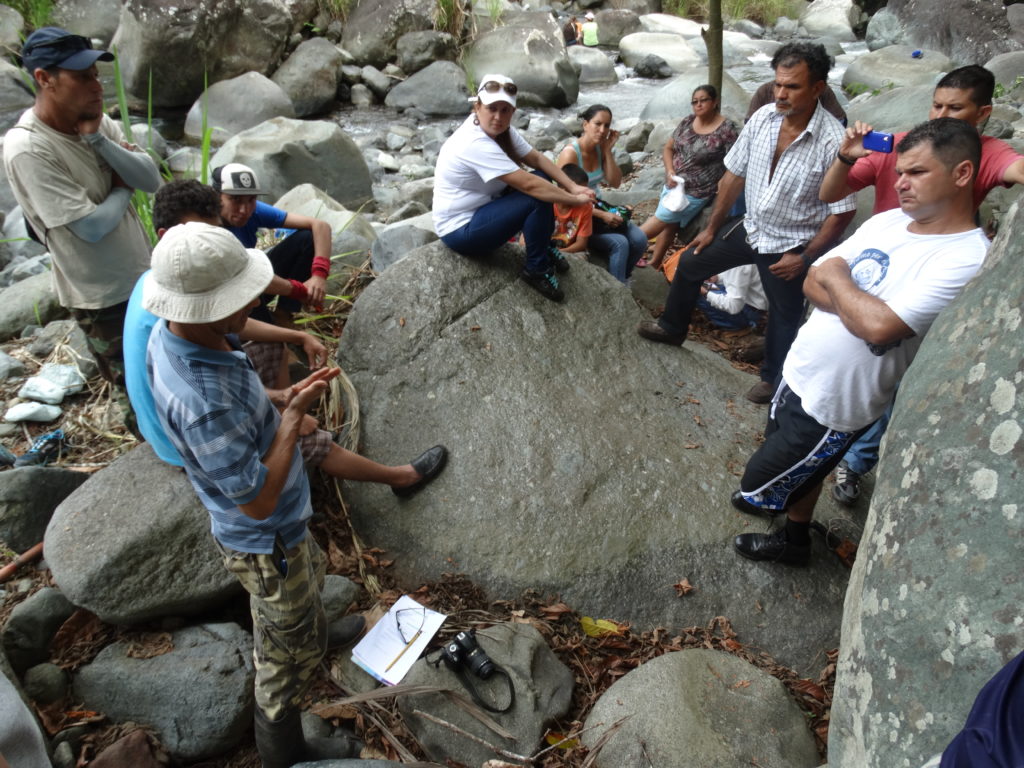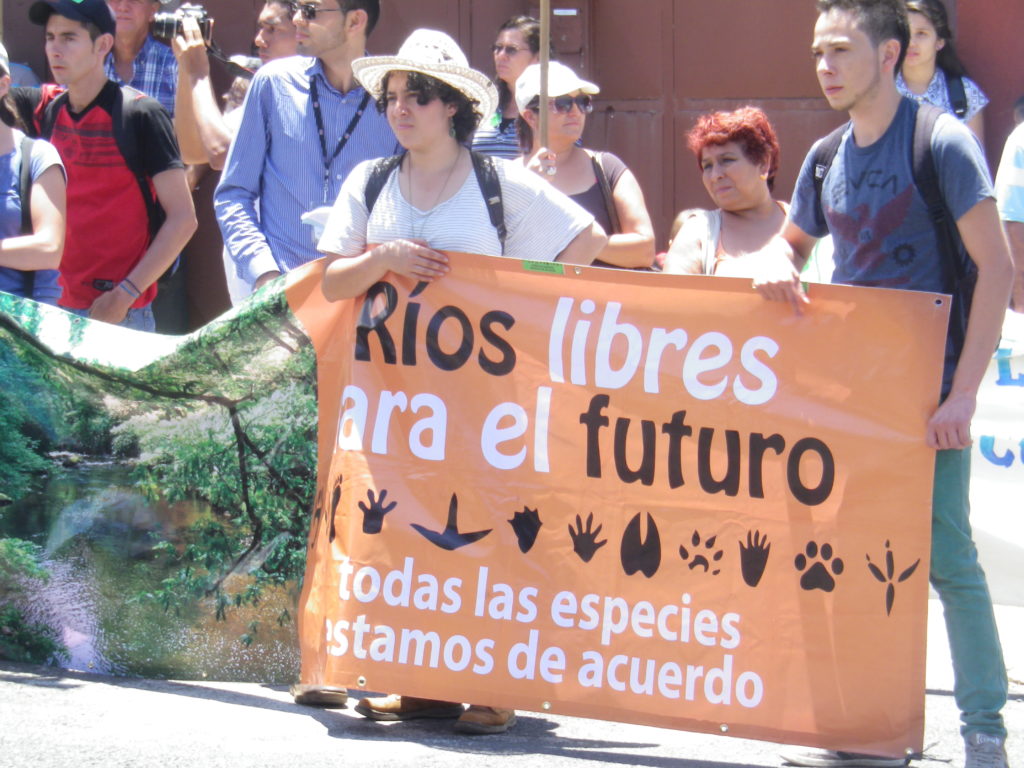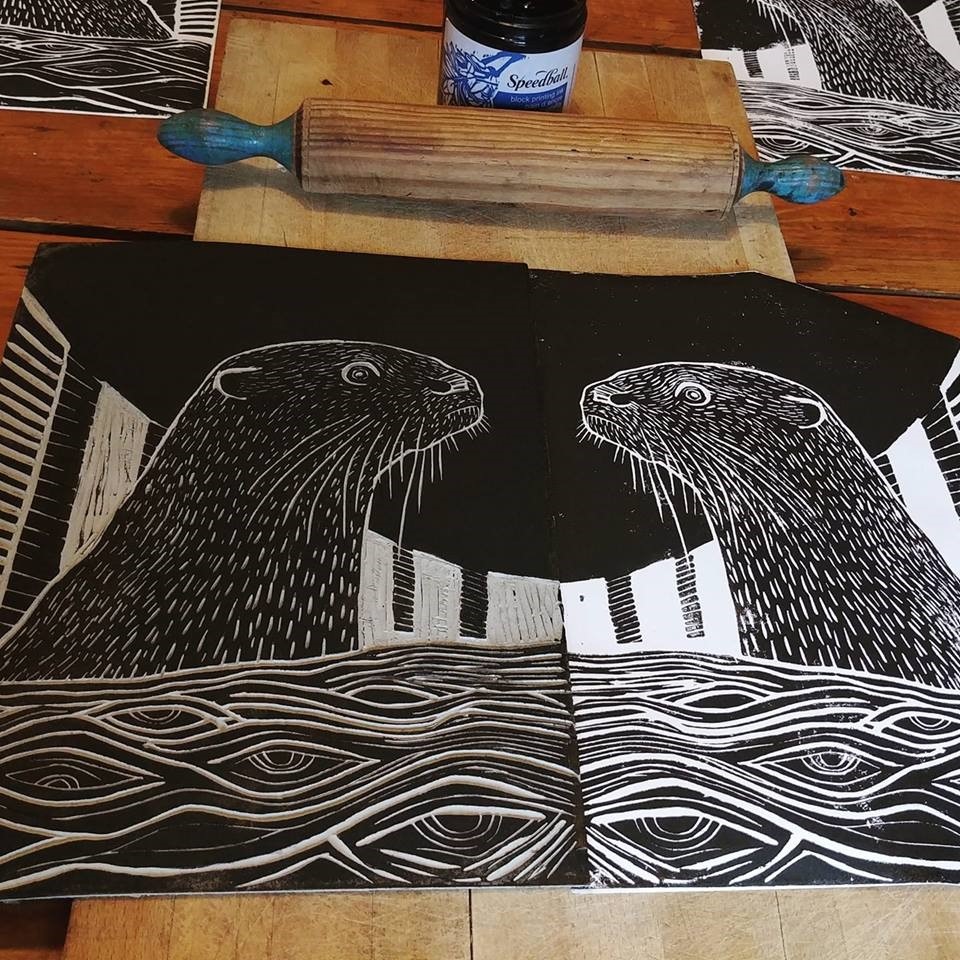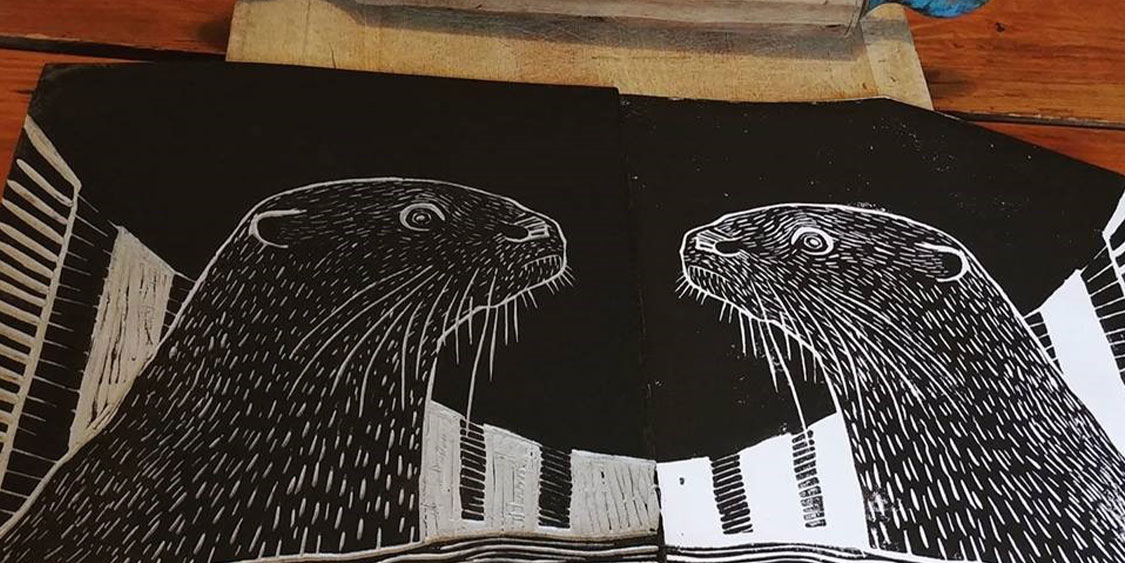Francesc Rodríguez
Abstract: For the past two decades, dozens of rivers in Costa Rica have been threatened by the plans of hydroelectric developers to build private run-of-the-river dams. Local communities adjacent to the rivers located between the Talamanca Mountain range and the Pacific Ocean stopped this attempt at hydroextractive expansion after a years-long struggle against dams and in defense of life. Based on a multi-species ethnography, in this article I show how the georgia alcohol rehab otters that inhabit these rivers, are also protagonists of this struggle. To do so, I expose the multi-species coalition formed in these communities in response to the absence of otters in the Environmental Impact Assessment of the San Rafael hydroelectric project.
Keywords: hydroextractivism, socioenvironmental conflicts, multi-specie coalition, ethnography, Costa Rica
Introduction
In April 2015, the San Rafael River welcomed us on the rocks of its riverbed.[1] There sat several families from rural communities adjacent to the river and two members of the Rios Vivos de Costa Rica movement, with whom I had traveled from San Isidro de El General, the capital of the canton of Perez Zeledon.
- “Are there otters here?” inquired Jorge, one of the members of Rios Vivos, his voice resonating loudly.[2]
- “Yes, water dogs…” replied an individual from the gathering, accompanied by nods of agreement from others who seemed to validate his sighting.
Following a brief pause during which only the gentle murmur of the river could be perceived, Jorge spoke up:
- Indeed, it’s crucial to be informed about this, as otters are granted protection through international treaties.[3]
After another moment of silence, Jorge turned his head from side to side to address the gathered individuals encircling him and remarked:
- We need to search for endangered species in this river, and otters are one of them.
This gathering of local residents and Rios Vivos de Costa Rica members is another step in the ongoing community effort to prevent developers from constructing dams for exporting hydroelectric power.[4] These hydro-extractivist dam plans, which involved diverting water away from the river, leaving parts of it almost dry, were proposed by developers for different places in Costa Rica, mainly in the southwest, starting in the 2010s.[5] In the end, the dams were not built. In the case of the San Rafael hydroelectric project, it was due to the denial of the declaration of national convenience for the project by the Minister of Environment and Energy (resolution N.o 0010-2019-DE of 2019). A key element in making that decision was the successful communal resistance in what represents a growing movement for the defense of communal life, not only near the San Rafael River but also in other areas of the country (AJA [Environmental Justice Atlas], 2019; Pearson, 2011). But, although the projects were stopped in the end, they all obtained environmental viability through a positive Environmental Impact Assessment (EIA).[6]
Using the lenses of Science and Technology Studies (STS) and Human-Animal Studies, in this article I show the more-than-human coalition that emerges during a conflict over dam development in response to the lack of recognition of protected species, like otters, in the EIA of the San Rafael dam project. Scientific knowledge produced in the EIA plays a key role in this and other socio-environmental conflicts. Under the environmental regime, known as sustainable development, introduced in Costa Rica during the 1980s and 1990s (Isla, 2015), this type of knowledge is a key tool to evaluate the requirements of what is considered to be sustainable or not.
This article emphasizes that socio-environmental conflicts, while encompassing ecological-distributive components (Martínez-Alier, 2006), also extend to matters of ontology, or in other words, to particular ways of existence and interactions of both human and more-than-human beings within communities. As Raftopoulos (2017) argues, interrogating the ontological assumptions of socio-environmental conflicts, including the connections between human and non-human worlds, is key to challenging the principles about life rooted in current development models. In this case, it is about whether or not dams should be built in relation to their environmental viability.
Absences and presences of otters in a socio-environmental conflict
The EIA includes a section on species protection. However, the EIA for the San Rafael hydroelectric project notably lacks any mention of protected species. The EIA study states, «No endemic species were found, with reduced populations or in danger of extinction for both the flora and fauna» (GAPRO, 2013: 61). Consequently, hydroelectric projects, including the one discussed in this article and those implemented along neighboring rivers, obtained environmental feasibility without significant alterations to their initial plans. Nevertheless, as I illustrate below, this EIA portrays a river devoid of protected species like the otter, a portrayal that does not align with the actual river that crosses the community, where one of these species does indeed inhabit, as the people who live there already well know.
Certainly, otters are an integral part of the community surrounding the San Rafael River. Following the initial encounter over the river, which marked the beginning of this article, I had the opportunity to engage with more neighbors who had also observed otters. For example, Giovanni, a local farmer, told me, as we walked along the river:
I was very curious about what Jorge was saying, about the otter, the water dog. Without a doubt, there are water dogs here. Some guys from the University of Costa Rica came to those rocks, and an anthropologist too, and we saw one. Otters slide like this, and you can see their shiny backs.
Apart from Giovanni, I had the opportunity to converse with several other individuals who, in recent months, had also spotted otters, or water dogs, in the rivers where they go fishing or swimming with their families. For example, another resident from the nearby area told me this:
I have talked to some neighbors from Zapotal and San Jeronimo who usually go fishing in the San Rafael River and they assure me that they have seen many of these animals called otters. They are going to try to photograph them to have proof of this.
Furthermore, otters aren’t just found in areas near the rivers, as many people have confirmed. They are also part of the visual stories surrounding this socio-environmental conflict. As an illustration, during a demonstration against the dams in San José in March 2014, one of the banners highlighted the presence of the non-human community on the streets that day.
When I talked to the person who made the banner, Carlos, and asked him about the animals shown on the banner and their connection to the river where he lives, he told me he meant «the fish, otters, and other animals that live by the rivers.»
Otters also make visual appearances in other spaces of protest against the dams. For instance, I observed on many occasions that otters had been artistically incorporated into various community events organized to advocate for river protection. Thus, despite the absence of otters in the EIA, their presence becomes evident in other locations associated with this conflict over dam development.
In summary, although not featured in the EIA, otters form an integral part of the community and the conflict. And as such, they contribute to co-creating a more-than-human coalition in defense of life in common, encompassing the rural communities and the river as well (alongside other species).
Conclusions
The article indicates that omitting otters from the EIA study of the San Rafael River hydroelectric project might not provide an accurate picture of how these non-human animals interact with local residents in the area. Instead, it seems to be a way to achieve environmental viability and expedite the development of hydro-extractive dam projects. This is despite many residents having witnessed the presence of otters. A clear disparity exists between the omission of otters in the EIA and, on the contrary, their frequent presence within the communities bordering the San Rafael River. This ontological disjunction raises concerns about the validity of the official knowledge in this type of environmental assessment and, therefore, I assert that it is necessary to establish epistemological and ontological mechanisms to ensure that the testimony of the communities is recognized as reliable and binding knowledge. At present, it is possible to file a legal appeal to the National Environmental Technical Secretariat (SETENA) of Costa Rica to collect complaints and queries from people who disagree with the findings and conclusions of the EIAs. This is what is called a “legal apersonamiento”. Nonetheless, I argue that ensuring an accurate comprehension of rivers and their human as well as non-human environments for decision-making should necessitate more than just an a posteriori legal procedure like an “apersonamiento”. In doing so, the lack of scientific evidence regarding the presence of otters and other protected species in specific areas would not be automatically considered proof of their absence in those same areas, as was the case in the EIA of the San Rafael dam project under the existing model of environmental governance in Costa Rica, known as sustainable development.
Figure 1: Gathering on the San Rafael River. Own work.

Figure 2: Banner at the demonstration in San José defending the right to life of several species. Own Work.

Figure 3: Otters painted by artist and activist Raquel Bolaños. Source: Raquel Bolaños.

References
AJA (Environmental Justice Atlas), 2019. «Proyecto hidroeléctrico San Rafael, Costa Rica». Retrieved from https://ejatlas.org/conflict/proyecto-hidroelectrico-san-rafael-costarica, on May the 3rd of 2022.
GAPRO (Gestión Ambiental de Proyectos), 2013. Proyecto hidroeléctrico San Rafael. Estudio de Impacto Ambiental, EXP. D1-10685-2013.
Gutiérrez Arguedas, A., y D. Villalobos, 2020. «Proyectos hidroeléctricos y resistencias comunitarias en defensa de los ríos en Costa Rica: un análisis geográfico». Cuadernos de Geografía: Revista Colombiana de Geografía, 29 (1), pp. 133-151.
Isla, A., 2015. The «Greening» of Costa Rica: Women, Peasants, Indigenous Peoples, and the Remaking of Nature. Toronto, University of Toronto.
Macdonald, S., y C. Mason, 1992. «A Note on Lutra Longicaudis in Costa Rica». IUCN Otter Specialist Group Bulletin, 7, pp. 37-38.
Martínez-Alier, J., 2006. «Los conflictos ecológico-distributivos y los indicadores de sustentabilidad». Polis, 13, pp. 1-16.
Pearson, T. W., 2011. «Naturaleza, neoliberalismo y soberanía: la vida como espacio de lucha en Costa Rica». Biocenosis, 24 (1-2), pp. 45-53.
Raftopoulos, M., 2017. «Contemporary Debates on Social-environmental Conflicts, Extractivism and Human Rights in Latin America». International Journal of Human Rights, 21 (4), pp. 387-404.
Rheingantz, M. L., y C. S. Trinca, 2015. «Lontra longicaudis». The IUCN Red List of Threatened Species 2015, e.T12304A21937379.
Rodríguez, F., 2020. «Knowing Water Worlds: A Postphenomenological Approach to Socioenvironmental Imaginaries in Costa Rica». Yorkspace Institutional Repository (11 de agosto de 2020). Retrieved from https://yorkspace.library.yorku.ca/items/4742cc96-c653-42e2-b62b-9539ac14a164, on May the 30th of 2022.
—
[1] This participant observation experience along with the informal interviews in this article are part of a multi-sited ethnography conducted in Costa Rica between 2013 and 2016 (for more information, see Rodriguez’s doctoral dissertation, 2020).
[2] The dialogues presented in this article are translations from Spanish to English by the author.
[3] Otters (Lontra longicaudis) are protected in Costa Rica and other countries (Macdonald and Mason, 1992; Rheingantz and Trinca, 2015).
[4] Potentially through the controversial Electrical Interconnection System for Central American Countries (SIEPAC), driven by economic and political interests that advocate liberalization and privatization of the electricity sector in Costa Rica and neighboring countries.
[5] In total, fourteen hydroelectric projects were planned in an area of about fifty kilometers in a straight line crossed by several rivers (for more information, see Gutiérrez and Villalobos, 2020).
[6] Environmental Impact Assessment is based on a series of processes that include an Environmental Impact Study in the form of a written report. I sometimes refer to EIA as «assessment» and sometimes as «study», although the meaning is similar.








